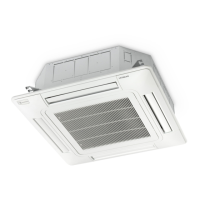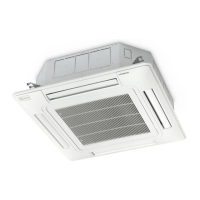4 Refrigerant Pipe
DANGER
UserefrigerantR32intherefrigerantcycle(refertooutdoornameplate).Donotchargeoxygen,acetyleneorotherammable
andpoisonousgasesintotherefrigerantcyclewhenperformingaleakagetestoranair-tighttest.Thistypeofgasesare
extremelydangerous,whichmaycauseanexplosion.Itisrecommendedtousenitrogentoperformthesetests.
4.1 Pipe Material
1 Prepare locally-supplied copper pipes.
2 Select the piping size from the following table.
Model Gas pipe (mm) Liquid pipe (mm)
3.0HP~3.5HP ∅15.88 ∅9.52
4.0HP~6.5HP ∅19.05 ∅9.52
3 Select clean copper pipes. Make sure that there is no dust and moisture inside. Blow the pipes with nitrogen or dry air to remove
dust and foreign materials before connecting pipes.
4.2 Piping Connection
1 Position of piping connection is shown in Fig. 4.1 (Indoor Unit).
(Unit: mm)
18 (Gas Pipe)
840 (Unit)
25 (Liquid Pipe)
840 (Unit)
Liquid Pipe Connection
Gas Pipe Connection
127 (Liquid Pipe Connection)
102 (Gas Pipe Connection)
180 (Liquid Pipe)
110 (Gas Pipe)
Fig. 4.1 Position of Piping Connection
2 When tightening the are nut, use two spanners as shown in Fig. 4.2.
Pipe Size
(mm)
Tightening Torque
(Nm)
∅6.35 20
∅9.52 40
∅12.7 60
∅15.88 80
∅19.05 100
Fig. 4.2 Tightening Work of Flare Nut
INSTALLATION AND MAINTENANCE
HO2019289HA
18

